Sara Ryan's Blog, page 8
March 15, 2014
Recently, soon
KAPOW! If you’re anywhere near Eastern Michigan University, go see this exhibit. I’d say that even if there weren’t pages from Bad Houses in it.
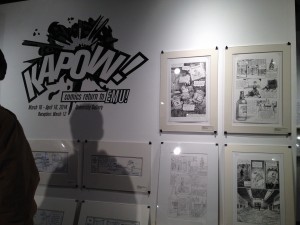
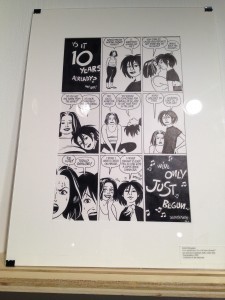
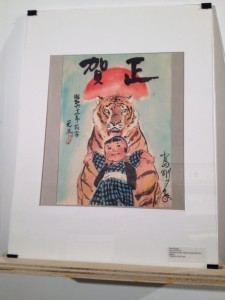
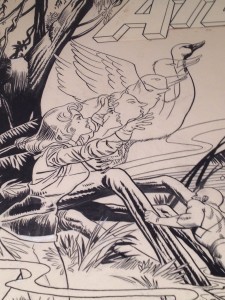
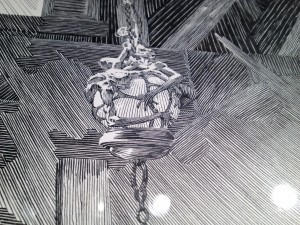
Then I went from Ypsi to Indy.

I confess I imagined a cell phone into this statue’s hand.
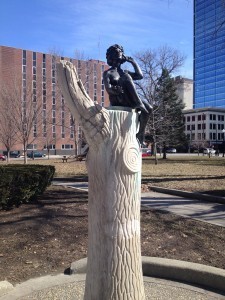
This gallery was technically not open but the nice curator let me wander around for a while anyway.

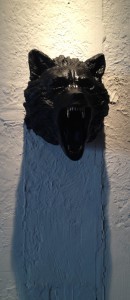
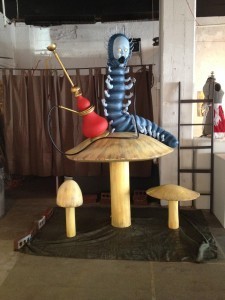
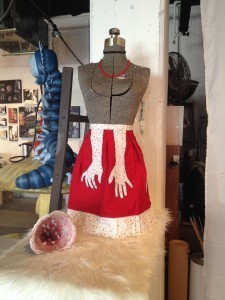
So that’s recently. Soon is Emerald City Comicon; I’ll be in the Periscope Studio area, booth 1214. Seattleites, hope to see you there!
March 4, 2014
So yes
I called my previous post “Catching Up” and then didn’t post for a month. Ha!
We had some weather.
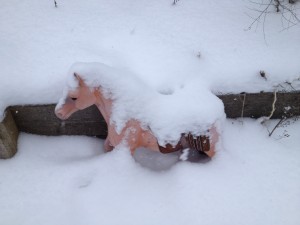
Less of it than many other places, but more severe than we usually get. Side effects of weather included the car’s demise and the concomitant need to acquire a different (but similar) car, which required time and agitation. I had a fervent desire not to become an extra in a dealership’s production of Glengarry Glen Ross. I managed to mostly escape hard-sell tactics though a salesman did set a fire on a car’s hood (not the one I bought) to demonstrate the magnificence of the space-age coating they had on offer (I did not buy the coating either).
But what I really wanted to tell you about was the reading I went to tonight; the inaugural edition of Camp Cataract, named in homage to a Jane Bowles short story.
It was at Floyd’s Coffee, and Donal Mosher and Sara Jaffe and Chelsey Johnson all read and there was also a musician who played two lovely haunting songs but whose name I unfortunately did not catch.
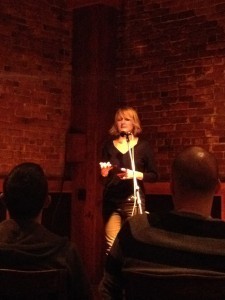
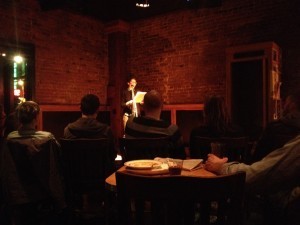
All the selections were both funny and poignant, with distinctly queer sensibilities that I really appreciated. I’m glad I was there, and I’m excited for the next installment of Camp Cataract!
February 5, 2014
Catching up
I’ve been home from my most recent travels for a little over a week. I thought I was leaving winter behind in the Midwest & East, but as I type the wind is so loud outside that if I didn’t know I was inland I’d swear I was hearing the ocean.
When I was in Philadelphia I went to the Mütter Museum and took a few photos on the sly. Tweeted this first one and will repeat myself: Appropriate subject juxtaposition on handsome old card catalog drawer.
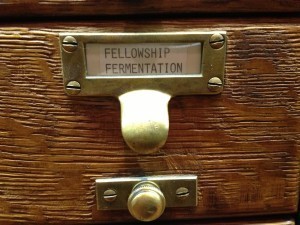
Shadow of a skeletal torso on the fancy carpet.
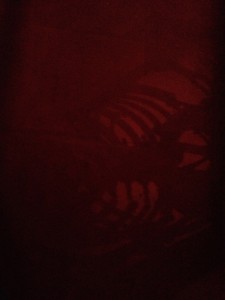
Glass eye.
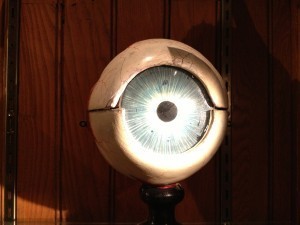
I also made a pilgrimage to the excellent comic shop/gallery/publisher Locust Moon. If you’re in Philadelphia go thou and do likewise. I bought a bunch of stuff:
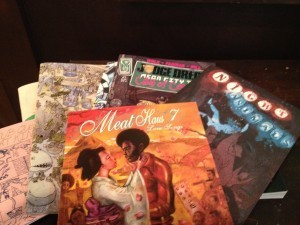
And enjoyed the aquarium,
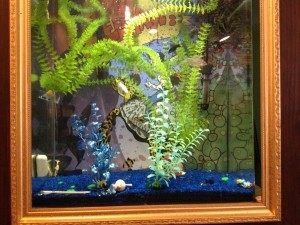
the locusts & moon,
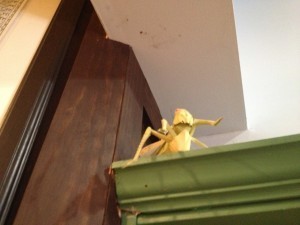
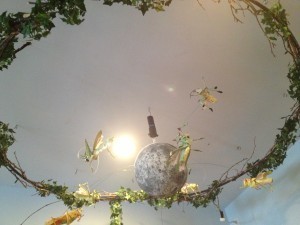
and the conversation, not pictured.
I saw some street art!
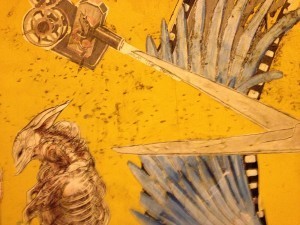
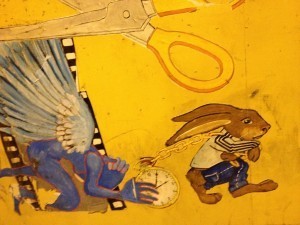
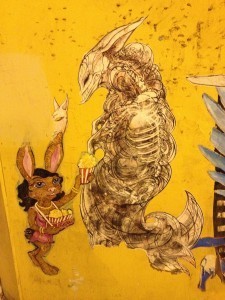
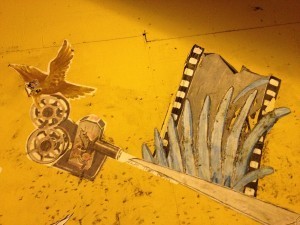

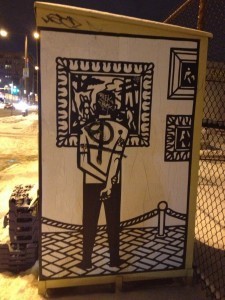
I signed a whole bunch of copies of Bad Houses!
And drew wall-eyed owls in many of them!
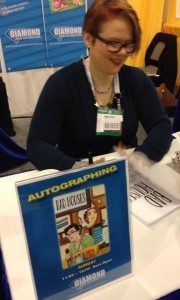
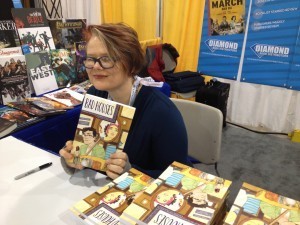
This is my friend & co-worker Lucien; yes that’s right, he is a Portland person but he came to Philadelphia for my signing! (N.B. that is not really why he came to Philadelphia.)
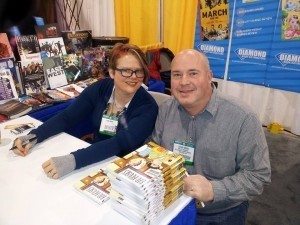
While in Philadelphia I got some swell news: in the fall I’ll be presenting along with Sara Zarr, Jo Knowles, Lauren Myracle, Matt de la Peña and Coe Booth at YALSA’s Young Adult Literature Symposium!
Finally, unrelated to any of the above: I can’t stop listening to the new Against Me! album Transgender Dysphoria Blues. Here’s the title song:
January 27, 2014
Connections #4
Full disclosure: this post is sort of cheating, in that I’m really just focusing on one artist and not making connections beyond her work. But seeing as this whole series is idiosyncratic, and also seeing that the work itself makes any number of connections, I’m not going to worry about it.
I went to the Fabric Workshop and Museum and saw the Sarah Sze installation. I didn’t know anything about Sarah Sze’s work, but after a long stretch of travel and convening, a museum seemed like the right place to go, and this one happened to be both conveniently located and open.
I put down my bulky coat to take pictures. Thought about taking a picture of my coat on the floor next to this coat, adding an element to the installation, but didn’t.
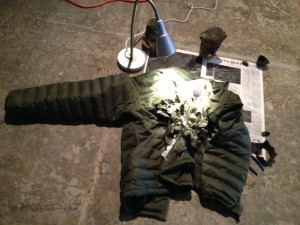
In this part of the installation, Sze used a lot of newspaper pages, replacing the photos on each with pictures of timeless, elemental substances — snow, water, ice, wood, rocks, sky, fire — sometimes with other items placed on top.
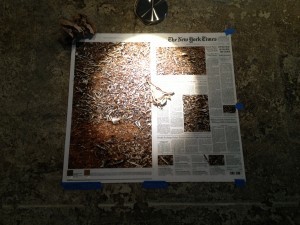
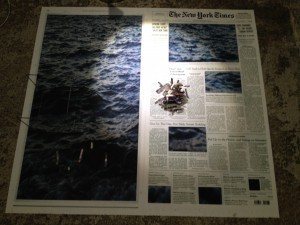
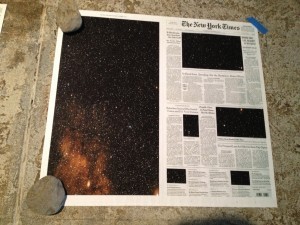
I particularly liked this one, the circular blue painter’s tape contrasting with the squares & rectangles of flame.
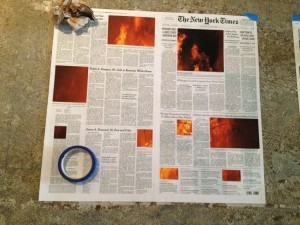
And this one, rocks and sky and light blue shards of…what? Not sure, but I love its placement.
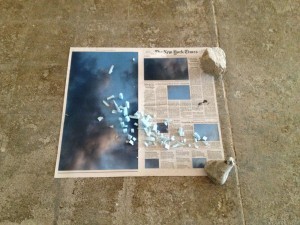
She clearly seemed to be incorporating the floor into the installation as well; its colors & textures acting as a frame/background.
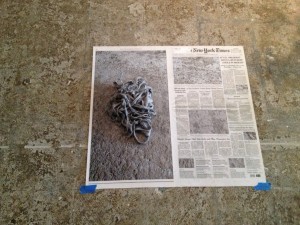
I can’t really convey the overall scale, but here are a few photos that give something of a sense of it:
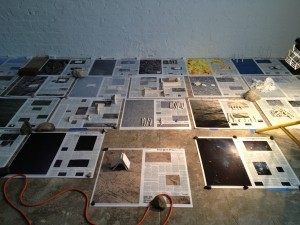
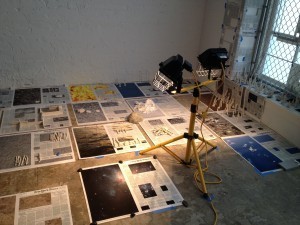
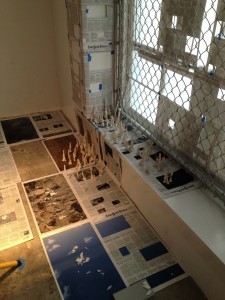
Two elements of the installation struck me the most solely because of my connection-craving brain. I asked the guide if there was any deliberate relationship between the articles in the newspapers and the images with which Sze replaced the accompanying photos. Apparently not; but these two juxtapositions of headlines & images worked especially well for me:
“There’s Lots to Gain by Keeping It Simple”
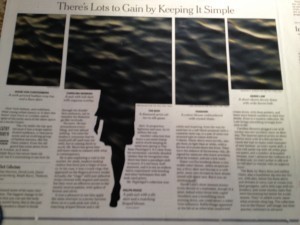
“Playing With Risk And Constraint”
“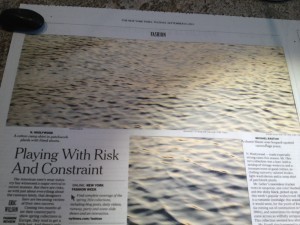
And I highly recommend this PBS video: Sze describing & showing some of her other work.
January 20, 2014
Connections #3
Yesterday I found this book on a free shelf.
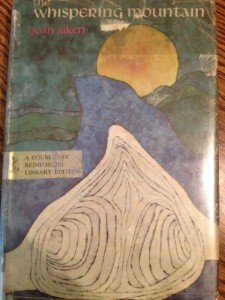
I remembered liking Joan Aiken‘s writing, though it had been a long time since I’d read anything of hers. I was also desperate for reading material.
I was not disappointed. The Whispering Mountain turns out to be a prequel to the Wolves Chronicles, of which the best-known title is probably The Wolves of Willoughby Chase. I’ve decided I need to reread them, since I seem to have missed several volumes. (Warning: the summaries given for the books on the site I linked above are spoilery. Which I suppose is only reasonable for books several decades old. But still.)
One of the many delightful words in The Whispering Mountain is dod-gasted, which I thought I remembered T.H. White’s King Pellinore using about his Questing Beast. A cursory search failed to confirm that particular connection, but did turn up an excellent article about obscenicons, aka grawlixes, aka the strings of characters used in place of swears in comics.
Another word from Whispering Mountain, bach, a Welsh term of friendly endearment, connected me to another book. The term is used liberally by passionate theater director Geraint Powell, a significant character in The Lyre of Orpheus, the concluding novel in the Cornish Trilogy by Robertson Davies. That link is to an interview with Davies which contains this quote: “I write novels that I hope will be interesting just as stories, but they also have implications and byways which I think would interest people who have more information.” Which perhaps is why I’m so fond of his books; not that I necessarily always have the “more information” he refers to, but that I am the kind of person who likes to ferret it out.
But any book set in Wales, which Whispering Mountain is, will connect me most strongly with a series that I, like many other readers, imprinted on at an early age: Susan Cooper’s The Dark Is Rising sequence. Not all the books in the sequence take place in Wales, but Wales is an important setting, and Cooper herself has strong ties to Wales.
Last connection: there’s a quote from The Dark Is Rising that keeps running through my head:
For all times coexist, and the future can sometimes affect the past, though the past is a road that leads to the future.
In Cooper’s context, times coexisting has to do with the work of the Old Ones and the struggle between the Light and the Dark. In mine, it evokes the fractured world that people with memory loss experience. Visiting, and hopefully comforting, someone with memory loss is the reason I am where I currently am; where I discovered that copy of The Whispering Mountain.
January 18, 2014
Signing at ALA Midwinter!
Are you going to ALA Midwinter in Philadelphia?
Do you want a free signed copy of Bad Houses, possibly with a bonus wall-eyed owl sketch?
Then come to the Diamond Book Distributors booth #424 Sunday, 1/26 from 11-noon and I will be happy to oblige!
January 13, 2014
Connections #2
The connections in this post are mostly of a very straightforward type: 1. Begin with something I love that many people were involved in making. 2. Track down other projects done by those people.
My starting point is Slings and Arrows, a brilliant Canadian series about the on and offstage drama at a regional Shakespeare festival. If you’re already a fan, I commend to your attention an excellent Onion A.V. Club interview with the creators, including among many other insights this quote from Susan Coyne on fear and insecurity: “It’s an essential component, actually, of the actor’s or the artist’s life. To be constantly not quite sure that what you’re doing is going to work out and that nervousness is where the sweet spot is. Just before the thread snaps, that’s where it’s really interesting.”
If you’re new to the series, here’s Season 1, episode 1:
From Slings and Arrows you can get any number of places; I’ll tell you about two.
Sarah Polley plays Sophie, the young actress who’s cast as Cordelia in the production of King Lear in Slings and Arrows’ third season. Throughout the series Michael Polley plays Frank, a longtime actor of bit parts at the festival alongside his companion Cyril. As you might guess from their identical last names, there is a relationship between these two actors. That relationship’s exact nature — as well as the nature of memory, the question of who has a right to tell a family’s stories, and who gets to decide what makes someone part of a family, or not — is examined in Sarah Polley’s amazing film, Stories We Tell. The less you know going in the better, so that’s all I’ll say. Here’s the trailer:
One of my favorite characters (although it’s very difficult to choose) from Slings and Arrows is the flamboyant director Darren Nichols (“Deal with that!”), played by Don McKellar. So when friends told me that he’d co-created and starred in a show in the nineties called Twitch City, playing a Torontonian television addict named Curtis who never leaves the apartment he shares with a series of roommates, most notably Holly, played by Molly Parker whom you may know from Deadwood, I was immediately all in.
Here’s Episode 1, Season 1:
If you love it as much as I do, I suggest buying the complete series on DVD. I agree with this review describing the show as the TV equivalent of an underground comic, though I differ with the reviewer about the special features. It’s true that there’s only commentary on two of the thirteen episodes, but it’s absolutely worth it just to hear McKellar leave voicemail for some of the other actors he hoped to include on the commentary track, but who weren’t answering their phones.
Final connection for this post, coming way out of left field: I was reading Michael Pollan’s “The Intelligent Plant: scientists debate a new way of understanding flora” and came across this passage:
The “sessile life style,” as plant biologists term it, calls for an extensive and nuanced understanding of one’s immediate environment, since the plant has to find everything it needs, and has to defend itself, while remaining fixed in place.
Sessile is a perfect description of Don McKellar’s Twitch City character, Curtis.
January 6, 2014
Connections #1
I’m the daughter of two librarians. I internalized early on that whenever I wanted to know more about a word or person or event, the appropriate response was to Look It Up: find the definition, biography, historical & cultural context.
Whether or not I actually did Look It Up was an indication of how interested I really was. If my curiosity was merely idle, I’d drop the topic. But more often than not, the connections I made kept me going. (And yes, I love the James Burke series Connections.)
So I thought I’d start a series here of some of the connections I’m currently making. Each one will cover a few links in a chain of associations. Starting and stopping points will be somewhat arbitrary to keep the posts from getting too unwieldy. Here we go!
1. I read Stephen Burt’s essay on George Eliot at Essay Daily. I hadn’t known the site before. Since I both enjoy reading essays and want to get better at writing them, I added Essay Daily to my feed reader.
2. At Essay Daily I read Ryan Van Meter’s essay on endings which mentions a children’s book called A Really Weird Summer. Any time someone who is not themselves involved in writing children’s or YA literature references it, it piques my curiosity. Especially if, as was the case here, no contempt or oversweet nostalgia accompanies the reference. Plus, the author’s name seemed familiar.
3. So I checked out & read A Really Weird Summer by Eloise McGraw, whose name, it turns out, was familiar because the Oregon Book Awards for children’s literature are named for her. As I read I thought a lot about the book’s tone. There’s the real-world hardship of the kids’ parents’ in-progress divorce, their being shipped off to live with distant relatives for the summer, Nels’ tremendous sense of responsibility for his younger siblings and equal amount of resentment that the responsibility has been foisted onto him, juxtaposed with the secret room that Nels discovers, and the lure of its secret inhabitants.
4. I was struck by the ominous front cover and the very trippy back cover; those images, in combination with the tone, were reminding me of something I couldn’t quite immediately place. I decided to research the illustrator.
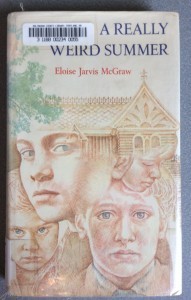
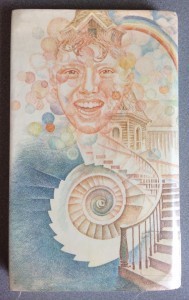
5. The illustrator is Allen Davis. As soon as I saw a few more examples of his cover design style, I remembered what A Really Weird Summer made me think of: the books that Suzy Bishop carries in Wes Anderson’s Moonrise Kingdom.
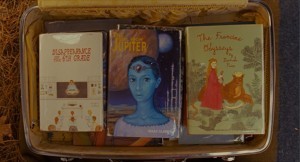
Those books, which don’t actually exist, are inspired by books from the 1960s and 70s, the era when A Really Weird Summer was published.
One last link: as I was writing this post, a friend tweeted at me about an essay he was reading involving mixtapes, bargain bins, Upper Michigan, and tree roots, which reminded him of some of what I was writing about in Bad Houses.
Taking us full circle, the essay was by Ander Monson, who coordinates Essay Daily.
December 30, 2013
An old year resolution and a day trip
A friend recently introduced me to the idea of old year resolutions: considering how you want to leave a year as well as, or instead of, how to begin it.
We had this conversation right before the holidays, and the old year resolution that came to my mind was this:
Make up stories about characters, not about the actions of others.
Of course, it’s a nearly impossible goal. So much of human interaction is based on guesswork and oracle-like acts of interpretation; why’d they say that, why’d they do that, don’t they know, didn’t they think?
But I like my old year resolution as a reminder of where to focus my energy.
And the day trip: we went to the Mount Angel Abbey. I didn’t know much about it, except that my friends had been before and were enthusiastic about it, and described the abbey’s museum as a wunderkammer.
Indeed.
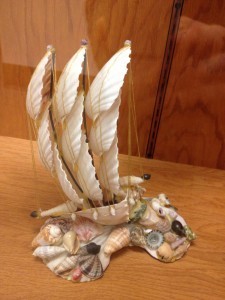
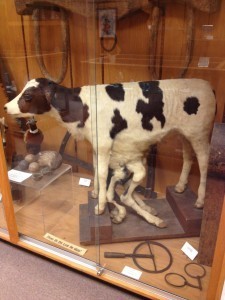
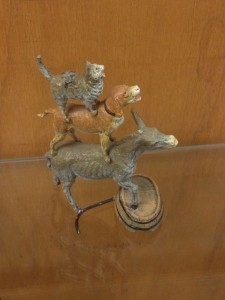
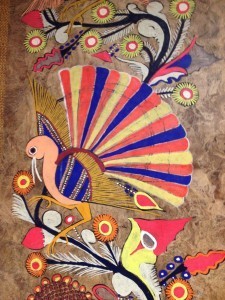
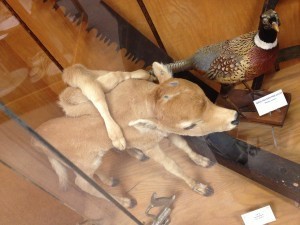
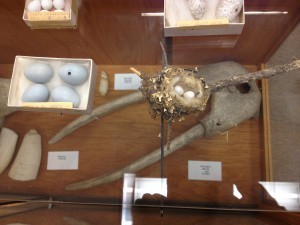
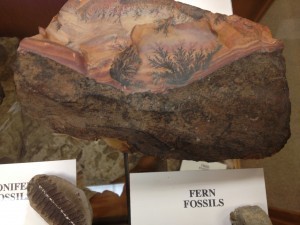
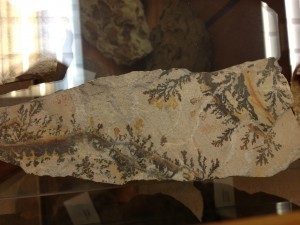
We got to talk for a while to the affable and erudite monk working in the museum. The words on his knuckle tattoos also serve as an appropriate resolution, old year or new: HOLD FAST.
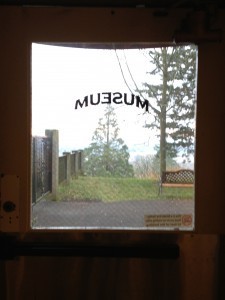
December 18, 2013
Cuteness, braggyness, and a PDX event
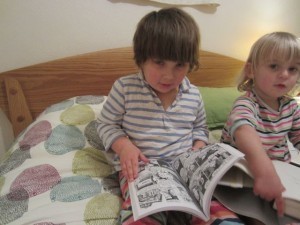
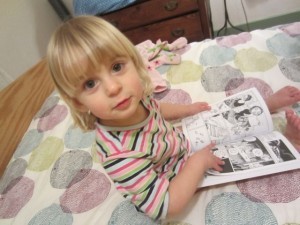
Bad Houses finds readers outside its target demographic,* is reviewed along with several excellent titles from Portland creators in the Mercury with a memorable headline, and makes the iBooks Best of 2013 Comics & Graphic Novels list (warning: that link will attempt to open iTunes). So I felt compelled to document via screenshot:

N.B. If you’re looking for it inside iTunes/iBooks, you’ll have to scroll past several other categories, but trust me, it’s there!
And the event: I’ll be at Cosmic Monkey Comics from 12-2 on Saturday 12/21 along with several other folks, happy to sign copies of Bad Houses for you, your loved ones, and/or any hoarder friends you want to passive-aggressively troll.
* I do not actually recommend giving the book to small children, nor does my friend who sent the photos. But they’re pretty darned cute, aren’t they?



